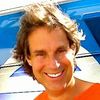Leonardo da Vinci, born in the middle of the 15th century, was the founder of modern science and an interpreter between nature and humans.
He sought to understand the nature of life two centuries before the microscope was invented. He believed the Earth was a living, self-organizing and self-regulating system.
Leonardo had exceptional powers of observation and a powerful visual memory. And his "sublime left hand" (as his friend and mathematician Luca Pacioli, called it) drew in excess of 100,000 drawings in over 13,000 pages. Some 6,000 pages were preserved as manuscripts now in libraries and private collections, others in larger forms known as codies are held by the British Royal family and Bill and Melinda Gates.
As a young man Leonardo trained as a painter, sculptor and engineer in Florence. Astonishingly, he was a self-taught scientist, inventor, designer, mathematician, linguist, systemic thinker, cartographer, geologist, ecologist, botanist, hydrologist, complexity theorist, humanitarian and physicist.
He was humble, compassionate, graceful, talented, sensitive, regal spirited, physically beautiful, eloquent, charming, practical joker and he possessed an insatiable thirst for knowledge.
Over 100 years before either Galileo or Bacon, Leonardo developed a new empirical approach to science -- systemic observations of nature, logical reasoning and some mathematical formulations, all the backbones of today's scientific methods.
Leonardo's uncanny ability to draw complex swirls of turbulent water and swift movements of birds was so accurate that nothing could match it until the advent of photography over three hundred years later.
He believed that in order to paint nature he must first understand it. By studying patterns in nature this enable him to transcend all boundaries.
His studies of muscles and bones lead him to invent gears and levers, interrelating physiology with engineering. His observations and recordings of turbulence in water enabled him to understand the flow of air, which in turn allowed him to explore sound, theory of music and the design of musical instruments.
His experiments in mathematics on continuous quantities were as a result of his incomparable drawings in nature. His science was inexorably linked to his art and vice versa.
The lists of his inventions -- some 300 -- are phenomenal including: wind and humidity gauges, odometers, small submarines for marine warfare, air bags, goggles and flippers for frogmen to bore holes in the planks of enemy ships, table lamps with variable intensities, opening and closing automatic doors using counter weights, folding furniture, revolving theatrical stages, a spit with variable speeds based on the intensity of the roasting fire, a press for olive oil, sewing-, spinning-, weaving-, twisting hemp-, trimming felt-machines.
A ten-year project on a monumental bronze horse that was never cast resulted in an extraordinary treatise on horses, which is now part of a special volume of the Royal collection at Windsor castle.
As an architect he focused on design, which included villas, palaces and cathedrals, and he was often consulted as an expert on architectural problems. His architecture was interwoven with complex geometry; and central to every villa and palace that he worked on were its gardens.
In 1482 he witnessed the Bubonic Plague in Milan and quickly deduced the city's appalling sanitation as the culprit. He submitted a proposal to rebuild the city with decent housing, shelters for animals and streets to be regularly cleaned by flushing them with water.
He designed ideal cities to contain no more than 30,000 people with two levels - upper for pedestrians, lower for vehicles with stairs interconnecting them and underground canals to carry sewage away.
In 1980 the World Health Organization modeled it Healthy Cities Program based on Leonardo's design of a city as a living system - 500 years later.
Leonardo worked on the human eye for over 20 years and his research on optics, anatomy and neuroscience ranks amongst his finest achievements.
His drawings of trees, plants, water and rocks are breathtaking.
Leonardo's work on human anatomy was based on hundreds of postmortems; and he brilliantly diagnosed that one older man died due to thickening of his arteries - 300 years before arteriosclerosis was discovered.
His renowned inventions of flying machines were truly amazing and all based upon thousands of hours of observing the birds on the hills outside Florence. Recently, his glider model was built and tested on the cliffs of southeastern England and its engineers noted that it super ceded the first attempts of the Wright Brothers in 1900.
A self-proclaimed vegetarian, Leonardo felt that with movement animals could experience pain. He often went into the marketplace, bought caged birds and immediately release them.
His belief that all inventions came from nature's blueprint occurred 500 years before the applied engineering field of biomimetics was created.
His love of nature and passion for all life stands as a beacon for all that is good in humankind and I can't help but think that even the master Renaissance designer, engineer and scientist knew so "Read me, O reader, if in my words you find delight, for rarely in the world will one such as I be born again."
Dr Reese Halter is a Science Communicator: Voice for Ecology, conservation biologist at Cal Lutheran University and public speaker. He is the author of Wild Weather -- The Truth Behind Global Warming. Contact him through www.DrReese.com
